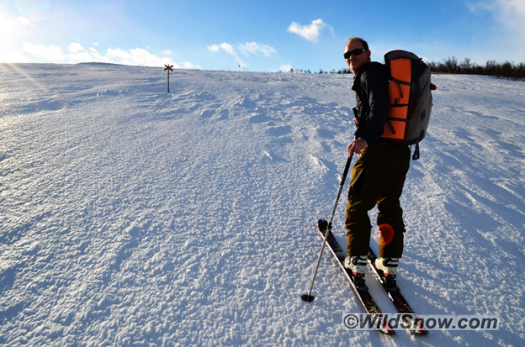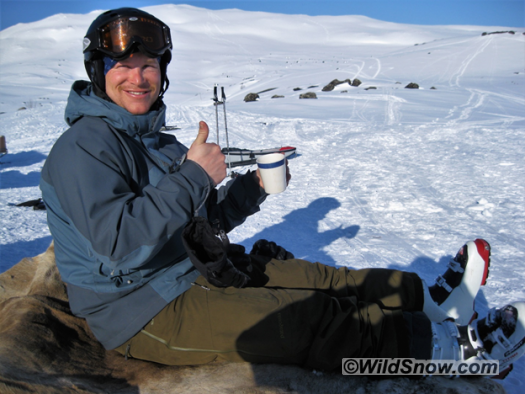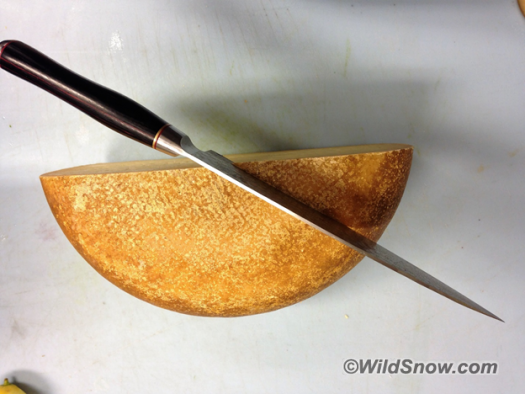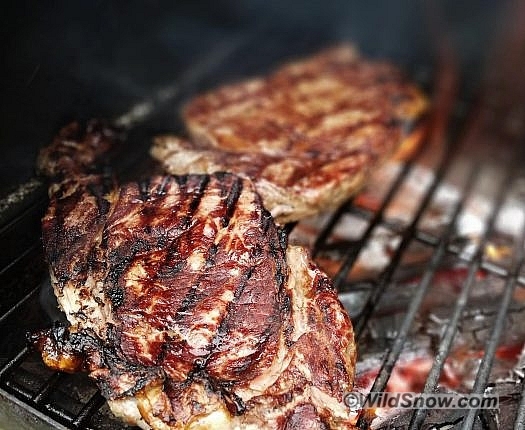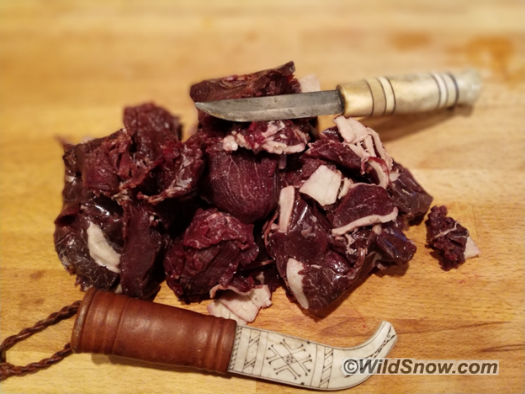Aaron Schorsch (text and photos)
Post sponsored by our publishing partner Cripple Creek Backcountry
From climbing iconic peaks in breakneck time, to cycling and running immense distances without pause, people everywhere are pushing the envelope and racking up the statistics. Ski touring is no exception. Our phones and watches track our steps, distance, altitude change, heart rate, and a slew of other data points. “Goos,” gels, and other energy-rich food replacements are being slurped down not just by elite athletes, but by neighborhood runners on Sunday morning. In our quest for new heights we have demanded food that is fast and effective, so that we can continue our onslaught of whatever mountain, river, forest, meadow we desire. We are moving quickly, I’ll give it that. But where are we going, and why?
Ski tourers are already a slightly different breed from our inbounds cousins, many of whom regard us as unhinged: “Ski up the mountain? You must have dismal understanding of gravity,” they say. While there are certainly a range of reasons for why people ski uphill (exercise, access to fresh lines/snow, sense of accomplishment, not wanting to pay a week’s paycheck for a lift ticket, etc.), I think that for many of us it might boil down in some way to the enjoyment of nature.
Why do I ski tour? I can witness a weasel running over and under the snow like a sewing needle, see where the fox stuck his head in the snow, and I can listen to the muted silence of an old growth forest under a blanket of snow. Then I can blast through that powder on the way down, my legs and body eagerly inhaling the vertical they gained a short time ago. Also all that work skiing up the mountain helps build up a healthy appetite.
I led a fly-fishing trip to Swedish Lapland this summer, and I was reminded of Swedes’ love of the outdoors. It is part of their national identity. Swedes love spending time outside (especially when the sun is out), but they also dress appropriately for a wide range of temperatures. They treat eating outside as a time to be savored and enjoyed, not an event to simply refuel the body. This often translates into building a fire, cooking sausages or other meat on sticks (or whole fish plucked from the lake or river), devouring slabs of hard cheese on rye bread slathered with butter and maybe a cucumber, and of course boiling coffee (kokkaffe) and noshing pastries. Benches are carved from the snow, down jackets donned, foam pads or reindeer hides are spread out, and time is taken to stop and enjoy the act of eating and being outside.
When my wife and I first moved to Sweden my wife exclaimed “now I see why some people say we are related to flowers,” in reference to gaggles of Swedes sitting in outdoor cafes, in sub freezing weather with their faces all aimed at the sun. I am not sure what research she was referencing regarding people as flowers, but I saw her point.
So what foods can you bring ski touring that remain real food, but are not difficult to transport or prepare? My ideal victuals depend on where I am. If I could choose anything I would bring the excellent cheeses, charcuterie (cured meats such as jambon cru, the French version of prosciutto), ham, saucisson sec (salami), viande seché (air dried beef), crusty bread, and chocolate that can be found in France, Switzerland, Italy, Germany, Austria, and Spain for little money and with great ease. If the weather is going to be bad then a sandwich is certainly the easiest way to go, but I prefer to bring everything as components and eat as if it was a cheese and charcuterie board, nibbling on a bit of cheese and bread, then taking a bit of prosciutto, and carrying on like that.
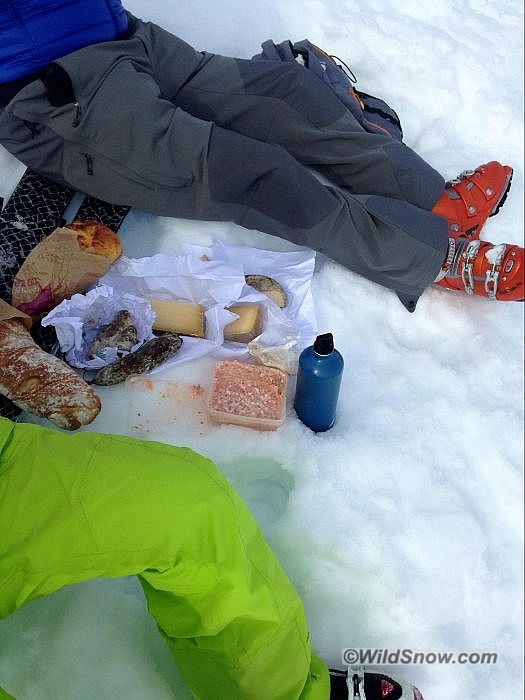
A crusty bread, a couple of hunks of cheese, some dried sausages, and you are set! If you are eating outside like this in France, someone will invariably ski by you and yell a cheery “Bon Appétit! Photo by Aaron Schorsch.
I also love to try new things and am often tempted by a slab of rabbit pate’ or a thick slice of almond nougat. If I am doing an overnight trip, or a trip with friends where food plays a central role, then cooking meat (sausages are great) or hearty cheese dishes make for a memorable meal. Also depending on how cold it is where you ski tour, I strongly recommend bringing ice cream. Remember up until the invention of freezers in the 1850s most ice-cream or similar treats were likely only enjoyed during the winter. The great thing about ski touring with ice cream is that you can eat it at very leisurely pace (I often stick my chocolate and almond ice cream bar in the snow between laps — the tasty reward awaits, inspiring yet another go).
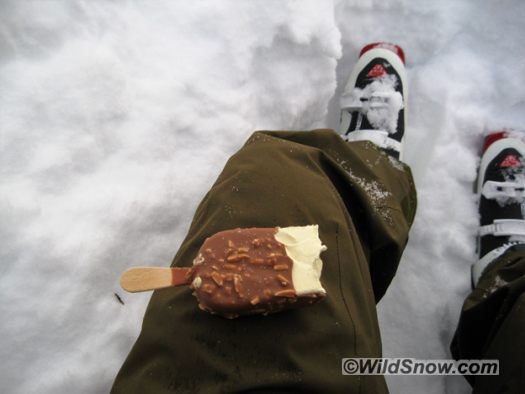
Yes I am a bit crazy for bringing ice cream while touring, but it just makes sense! Photo by Aaron Schorsch.
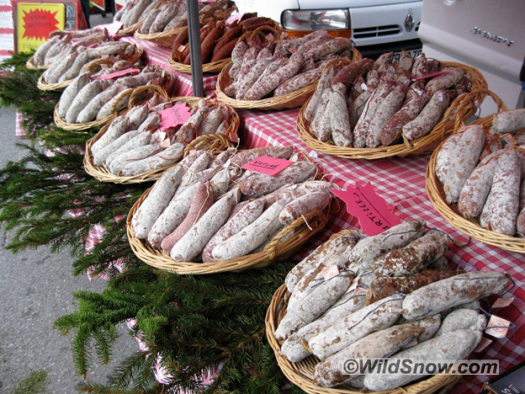
You can’t go anywhere in France without running into “saucisson sec,” a delicious and satisfying fuel for ski touring. Photo by Aaron Schorsch.
Some of my other favorite things to eat while ski touring:
If you are planning on spending the night in a ski touring hut or in a tent and have a good way to cook then I definitely recommend trying out some of the following ideas:
Raclette- This is a cheese based dish that originates from the French and Swiss Alps. Cow herders would place a large slab, or even a half-wheel of cheese, next to the fire and when the outside edge became hot and bubbly they would scrape (“racle” in French) the cheese onto bread or boiled potatoes. This dish is usually served with charcuterie (cured meats such as Prosciutto, salami, ham, coppa, etc) as well as cornichons (tarragon mini-pickles), pickled baby onions, and lots of white wine.
You can recreate raclette in several ways. Firstly, if you can purchase raclette cheese (available at many grocers with a good cheese selection) that is ideal, however many cheeses will work in this situation as long as they melt well and aren’t overly strong. I often save time by boiling my potatoes at home (choose waxy varieties such as Yukon gold). A wood fire imparts a nice smokiness to the cheese, so you may be able to place your large piece of cheese on slab of wood or bark covered with aluminum foil and put it next to the fire (or open the door of the woodstove if you are staying in a hut). Cooking on open fire is tricky and requires constant attention. A simpler method is to make a gratin of sorts by slicing your cooked potatoes into a pan and covering with slices of cheese and a touch of water (or wine), cover and heat until the cheese melts. Slice up a good saucisson sec (or a salami or ham) and have it at. I count 3-4 medium sized potatoes, plus about ½ pound of cheese, and 4-5 oz of cured meats per person. Cheese and potatoes will satiate that ski-touring hunger perfectly.
Meat- I am a huge fan of sausages. They are economical, flavorful, have no waste (like bones), thaw and freeze well (because of the salt and fat content), are easy to prepare and come in a slew of flavors. Bratwurst, hot Italian, Diots (the local pork sausage in Haute Savoie France that I love), kielbasa, and bangers as well as tons of poultry based sausages are widely available.
I often pack my sausages frozen (in a vacuum pack) and cook them in a pan (still frozen) by adding a little water and covering. Once they are thawed and hot I boil or pour off the water and brown them. Depending on what country your sausage’s country of origin you can pair them with sauerkraut, peppers and onions, potatoes, polenta, rice and beans, or just eat them on bread. For easy cleanup campfire cooking, impale them on stick. Don’t forget a good starch to go along and maybe some spicy mustard.
Wild meats- In Northern Sweden we ate tons of reindeer and moose meat, both of which were readily available, lean, delicious and tasted of the North. Perhaps you are a hunter and have access to elk or deer meat, or moose?. In Swedish Lapland “Souvas” (salted and cold smoked reindeer meat, usually from the leg) is very popular as it travels well, tastes great, and will flavor whatever you are cooking. If taking on the task of salting overnight and then cold-smoking over a birch fire for 8 hours seems ambitious to you, let me recommend simply marinating a cut that responds well to dry heat (such as from the leg or loin). I like a simple marinade of red wine, garlic, salt, a little oil, and bay leaf, but you can use whatever you like. Season the meat again with salt before cooking and grill or fry in butter or oil to your desired degree of done-ness.
If you are feeling adventurous and have built a fire, wait for the coals to form a thin layer of white ash. Crazy as this sounds place the meat DIRECTLY on the coals. That’s right throw the meat on the fire (make sure you have a way to retrieve it). The coals will sear the meat and at first they will stick. As the meat forms a nice crust the coals should release and you can flip them (I make tongs by bending a finger sized green branch in two). Cook until the meat releases on the other side, remove from the fire, let rest a bit, and enjoy. This technique is rather surprising but makes for delicious, smokey meat with no cleanup and without having to bring a pan! Plus you will impress your friends…or more firmly affirm to them that you are caveman or woman).
I ski tour on tech bindings because I love their elegance and substantial weight savings. While some people prefer to use that weight savings to achieve more vertical, I usually use it to bring more food! Thus my recommendation: next time you go out for a ski tour consider savoring your time in nature with an outdoor meal or just a hot cuppa and a cookie. Bon appétit!
As enjoying something more than trail mix for backcountry food might involve taking time out from uphill heat production, a few basic warmth tips for newcomers to human powered winter sport: Ski touring is sweaty work and while we may be overheated when we first stop, we can chill quickly due to our damp clothes (despite the care one should take with layering). Wearing a technical fabric (wool or synthetic, no cotton) next to the skin is thus recommended. I always have a down or synthetic jacket with me that I throw on shortly after I stop (it is much easier to conserve the heat you have worked up that to make it later when you are cold). Some people prefer to bring a heavy down or synthetic insulation vest (this is particularly good for very cold places) so that they can wear it over their ski jacket and not lose heat taking their ski jacket on and off. Also, avoid sitting directly in the snow or on a cold rock. We lose heat quickly through touching cold objects so use a closed cell foam mat, backpack, or some other insulating material for your derriere.
(Aaron Schorsch is the owner of Saveur the Journey, which specializes in outdoor adventures with a culinary and cultural focus to Europe, Japan, and beyond. He is a chef with a background in anthropology who loves combining skiing, eating, and travel. Aaron lives in Lexington, KY with his wife and young daughter.)
Beyond our regular guest bloggers who have their own profiles, some of our one-timers end up being categorized under this generic profile. Once they do a few posts, we build a category. In any case, we sure appreciate ALL the WildSnow guest bloggers!

